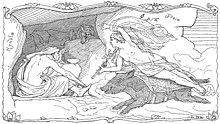Hildisvini

Hildisvini , also Hildiswini ( Old Norse Hildisvíni "fighting pig"), is a boar in Norse mythology that the goddess Freya uses as a mount. It has golden bristles and was created by the dwarves Dain and Nabbi . Only the Hyndlalied, the Hyndlulióð, tells of him . There it is also indicated that Hildisvini could only be the boar figure of the hero Ottar, with whom Freya entered into a relationship.
source
|
|
research
Freya's boar is very reminiscent of her brother Freyr's boar, named Gullinborsti . Both animals have a boar as a means of transportation, both animals have golden bristles and were created by dwarfs. It seems that the song poet Hyndlulióð Gullinborsti had in mind when he wrote the verses about Hildisvini.
It is probable that Hildisvini was not a figure in Nordic folk mythology at all, but rather came from a learned speculation. In the Nordic heroic legend there was an almost identical helmet called Hildisvin , which the poet of Hyndlulióð could have been familiar with, perhaps even from the prose Edda , which was written before his song. The name of the helmet suggests that the crest depicted a boar. According to the Prose Edda, the helmet was worn by the Norwegian King Áli in battle with the Swedish King Aðils. According to another, and more likely tradition of the English epic Beowulf , Áli (Onela there) was the uncle (mother brother) of Aðils (Endgils) and not Norwegian, but Swedish king before Aðils took the throne. The boar helmet thus apparently embodies a sacred symbol of the Swedish royal family, who saw themselves as descendants of Freyr , which gives a close relationship to the goddess Freya .
However, it is possible that a boar was considered an animal of the Freya, as she was also nicknamed Sýr "sow".
The hero Ottar could be traced back to a historical person who lived at the royal court in medieval Norway.
literature
- Rudolf Simek : Lexicon of Germanic Mythology (= Kröner's pocket edition . Volume 368). 3rd, completely revised edition. Kröner, Stuttgart 2006, ISBN 3-520-36803-X .
Individual evidence
- ↑ Otto Höfler : On the origin of heraldry. In: Otto Höfler: Small writings. Buske Verlag, 1992, p. 103 f.
- ↑ Lieder-Edda: Hyndlulióð 7
- ↑ Lieder-Edda: Hyndlulióð 5–7
- ^ Arnulf Krause: The songs of gods and heroes of the Elder Edda. Philipp Reclam jun. Verlag, Stuttgart 2004, ISBN 978-3-15050-047-7
- ↑ Lieder-Edda: Hyndluljóð 7th text edition based on the Titus Project, URL: http://titus.uni-frankfurt.de/texte/etcs/germ/anord/edda/edda.htm , accessed on November 19, 2009.
- ^ Translation by Arnulf Krause: Die Götter- und Heldenlieder der Älteren Edda. Philipp Reclam jun. Verlag, Stuttgart 2004, ISBN 978-3-15050-047-7
- ^ Rudolf Simek: Lexicon of Germanic Mythology (= Kröner's pocket edition. Volume 368). 3rd, completely revised edition. Kröner, Stuttgart 2006, ISBN 3-520-36803-X , p. 190.
- ^ Snorri Sturluson : Prosa-Edda , Skáldskaparmál , LIV. Frá Hrólfi hraka ok Aðilsi konungi
- ↑ Beowulf , verse 2379 ff.
- ↑ Compare Otto Höfler: On the origin of heraldry. In: Otto Höfler: Small writings. Buske Verlag, 1992, p. 103 f.
- ↑ René LM Derolez: De Godsdienst der Teutons. 1959 (German gods and myths of the Teutons, translated by Julie von Wattenwyl, Verlag Suchier & Englisch, 1974), p. 182
- ^ Arnulf Krause: The songs of gods and heroes of the Elder Edda. Philipp Reclam jun. Verlag, Stuttgart 2004, ISBN 978-3-15050-047-7 , p. 199
